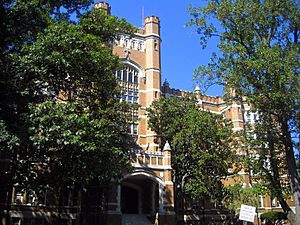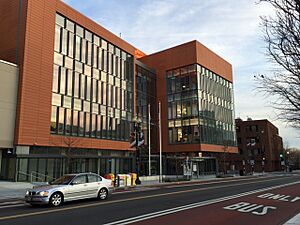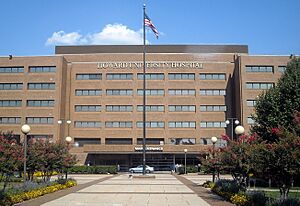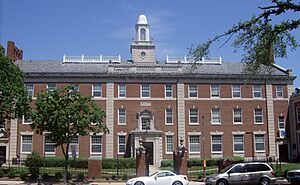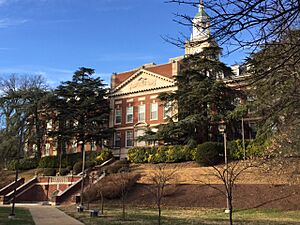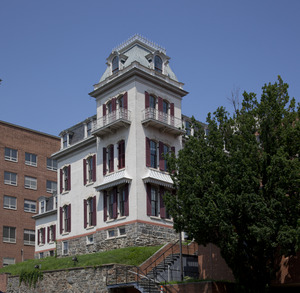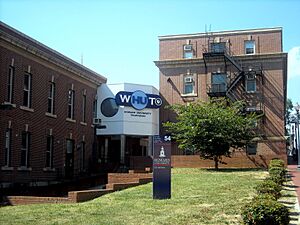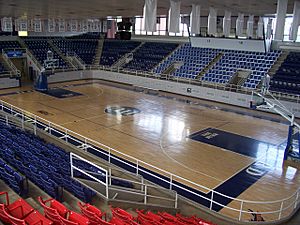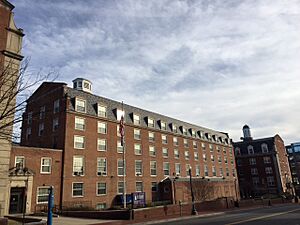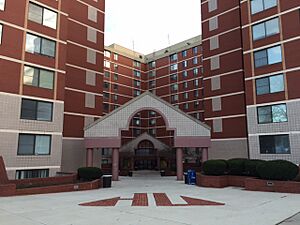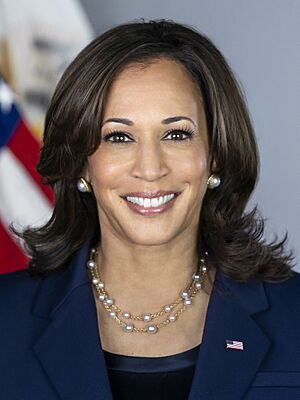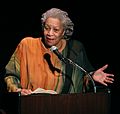Howard University facts for kids
 |
|
| Motto | Veritas et Utilitas |
|---|---|
|
Motto in English
|
"Truth and Service" |
| Type | Private federally chartered historically black research university |
| Established | March 2, 1867 |
| Accreditation | MSCHE |
|
Academic affiliations
|
|
| Endowment | $1.0325 billion (2024) |
| President | Ben Vinson III |
| Provost | Anthony Wutoh |
| Students | 12,941 (spring 2024) |
| Undergraduates | 9,797 (spring 2024) |
| Postgraduates | 1,795 (spring 2024) |
| Location |
,
United States
38°55′20″N 77°01′10″W / 38.92222°N 77.01944°W |
| Campus | Large city, 300 acres (1.2 km2) |
| Newspaper | The Hilltop |
| Colors | Blue Red Gray |
| Nickname | Howard Bison and Lady Bison |
|
Sporting affiliations
|
|
| Mascot | Bison |
 |
|
Howard University is a private university in Washington, D.C., USA. It is known as a historically black university (HBCU). This means it was founded to educate Black students.
Howard University is a top research university. It offers many different degrees. Students can study in over 120 programs. The university was started in 1867.
Contents
History of Howard University

How Howard University Started
After the American Civil War, people in Washington, D.C., wanted to create a school. They hoped to educate Black clergymen (religious leaders). Soon, this idea grew into building a whole university.
The new school was named after General Oliver Otis Howard. He was a hero from the Civil War. General Howard also helped start the university. He was its president from 1869 to 1874.
The U.S. Congress officially approved Howard University on March 2, 1867. Early on, the university got money from donations and tuition. Today, the U.S. government helps fund Howard University.
Howard University in the 20th Century
From 1926 to 1960, Mordecai Wyatt Johnson was Howard's first African-American president.
Howard University played a big part in the Civil Rights Movement. Many important leaders studied or taught there. Alain Locke wrote The New Negro, which was important for the Harlem Renaissance. Ralph Bunche, who won the Nobel Peace Prize, also taught at Howard.
In the 1940s, Howard students started "stool-sitting" protests. They sat at lunch counters that refused to serve Black people. This idea became a key tactic in the Civil Rights Movement. Students continued these protests around Washington, D.C.
Presidents of the United States have visited Howard. Calvin Coolidge spoke there in 1924. In 1965, President Lyndon B. Johnson gave a speech. He talked about his plans for civil rights laws.
In 1975, Howard University Hospital opened. It became the main teaching hospital for the university's medical school. Also in 1975, Jeanne Sinkford made history. She became the first female dean of any dental school in America.
In 1989, students protested the appointment of a new board member. This led to changes in the university's leadership.
Howard University in the 21st Century
In the early 2000s, there were some challenges with leadership. In 2014, Wayne A. I. Frederick became the 17th president.
In 2016, President Barack Obama gave a speech at Howard's graduation. He encouraged students to work for racial change.
In 2018, students held a sit-in protest. They were concerned about how money was being used. The protest ended with officials agreeing to meet most student demands.
In 2020, a large donation of $40 million was given to Howard. This was the biggest donation in the university's history.
In 2021, the university renamed its fine arts college. It became the Chadwick A. Boseman College of Fine Arts. This honored the late actor and former student, Chadwick Boseman.
Later in 2021, students protested living conditions in dorms. They wanted better housing and more student voice. In 2023, Howard invested $785 million to improve buildings. This included renovating and building new academic centers and housing.
In 2023, the U.S. Air Force chose Howard to lead a research center. This center focuses on technology for military systems. In February 2025, Howard University became a "Research One (R1)" university. This is a top classification for research activity.
Howard University Campus
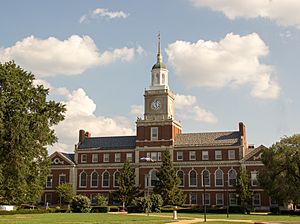
Howard's campus is about 256 acres. It is located in northwest Washington, D.C. Many people call the campus "The Mecca."
The campus has several historic buildings. These include Andrew Rankin Memorial Chapel, Frederick Douglass Memorial Hall, and the Founders Library.
The Howard University Gallery of Art has over 4,000 artworks. It is used by students for learning and research.
Howard University has several places for students to live. These are called residence halls. Some are for freshmen, and others are for continuing students.
Howard University Hospital is on campus. It was built on the site of a former baseball stadium.
Howard is also home to a commercial radio station, WHUR-FM. It also has a public television station, WHUT-TV.
Academics at Howard University
| ARWU World | 901–1000 |
|---|---|
| THES World | 201–250 |
| USNWR National University | 86 |
| Washington Monthly National University | 141 |
| Forbes | 273 |
Schools and Colleges
Howard University has many different schools and colleges. Each one focuses on a specific area of study.
- Howard University College of Engineering and Architecture
- Howard University College of Nursing & Allied Health Sciences
- Howard University College of Pharmacy
- Howard University College of Arts and Sciences
- Howard University Chadwick Boseman College of Fine Arts
- Howard University College of Dentistry
- Howard University School of Business
- Howard University Cathy Hughes School of Communications
- Howard University College of Medicine
- Howard University School of Law
- Howard University Middle School of Mathematics and Science
- Howard University School of Divinity
- Howard University School of Education
- Howard University School of Social Work
Special Programs
Howard offers special programs for high-achieving students. These are called honors programs.
The Martha and Bruce Karsh STEM Scholars Program helps students study science, technology, engineering, and math (STEM). Students in this program receive full scholarships. They are encouraged to pursue advanced degrees in STEM fields.
Google has a program called "Tech Exchange" with Howard. Students learn coding and tech skills at Google's campus. This helps more minority students get into the tech industry.
The Walt Disney Company also created the Disney Storytellers Fund. This fund helps students in fine arts and communications. It supports their creative projects and offers mentorship.
Research at Howard University
Howard has important research facilities. The Interdisciplinary Research Building (IRB) opened in 2016. It is a modern building for collaborative research.
The Moorland-Spingarn Research Center (MSRC) is a huge collection of materials. It documents the history and culture of people of African descent.
Howard also has a NASA University Research Center. It studies climate systems and trains future scientists.
The Ralph J. Bunche International Affairs Center helps students engage with global issues. It offers study abroad programs and scholarships.
Publications and Libraries
Howard University publishes The Hilltop, its student newspaper. It was started in 1924 by Zora Neale Hurston.
The university also publishes The Journal of Negro Education. This journal began in 1932.
The Howard University Libraries system has nine branches. The main library is the Founders Library. It was established in 1939.
Student Life at Howard University
Sports
Howard has 21 sports teams. They compete in NCAA Division I. Most teams are part of the Mid-Eastern Athletic Conference (MEAC).
Students and Organizations
Howard is one of the largest HBCUs. It has about 10,000 students. The university is selective, meaning it accepts a smaller number of applicants.
There are over 200 student groups and clubs on campus. Howard students have won many national scholarships. These include the Rhodes Scholar and Fulbright Scholar awards.
Howard is also the founding place for many Greek letter organizations. These are fraternities and sororities.
Campus Events
Howard Homecoming
Howard Homecoming is a very popular tradition. Over 100,000 alumni, students, and guests attend. It includes a football game, pep rally, and Greek Step-Show. The first official homecoming was in 1924.
Springfest
Springfest is an annual event in the spring. It is a smaller version of Homecoming. It includes a fashion show, talent show, and community service events.
Bison Ball
The Bison Ball is a formal event. Students, faculty, and organizations are honored for their achievements.
Resfest
Resfest is a competition week for freshmen living in dorms. They compete in sports, debates, and dance.
Famous People from Howard University
Howard University has many famous alumni. These are people who graduated from the university. They include:
- Kamala Harris, the current Vice President of the United States.
- Thurgood Marshall, the first African-American United States Supreme Court Justice.
- Toni Morrison, a writer who won the Pulitzer Prize and Nobel Prize.
- Chadwick Boseman, a famous actor.
- Zora Neale Hurston, a well-known author.
- Phylicia Rashad, an actress.
- Many members of the U.S. Congress, mayors, and leaders in different fields.
Howard University has given over 120,000 degrees. It has produced the most Black doctorate degree recipients of any university.
See also
 In Spanish: Universidad Howard para niños
In Spanish: Universidad Howard para niños
- Howard Theatre
- List of presidents of Howard University
Images for kids
-
Andrew Young, U.S. Ambassador to the UN and U.S. congressman from Georgia
-
Ras Baraka, mayor of Newark, New Jersey
-
Toni Morrison, Pulitzer Prize– and Nobel Prize-winning novelist
-
Zora Neale Hurston, author and anthropologist
-
Paul Laurence Dunbar, novelist and poet
-
Ta-Nehisi Coates, writer and journalist
-
Chadwick Boseman, actor
-
Phylicia Rashad, actress
-
Anthony Anderson, actor
-
Roxie Roker, actress
-
Taraji P. Henson, actress
-
Nick Cannon, comedian, rapper and television host
-
Gregory Meeks, United States representative for New York's 5th congressional district
-
Thomas Sowell, economist, author and social commentator (attended)



